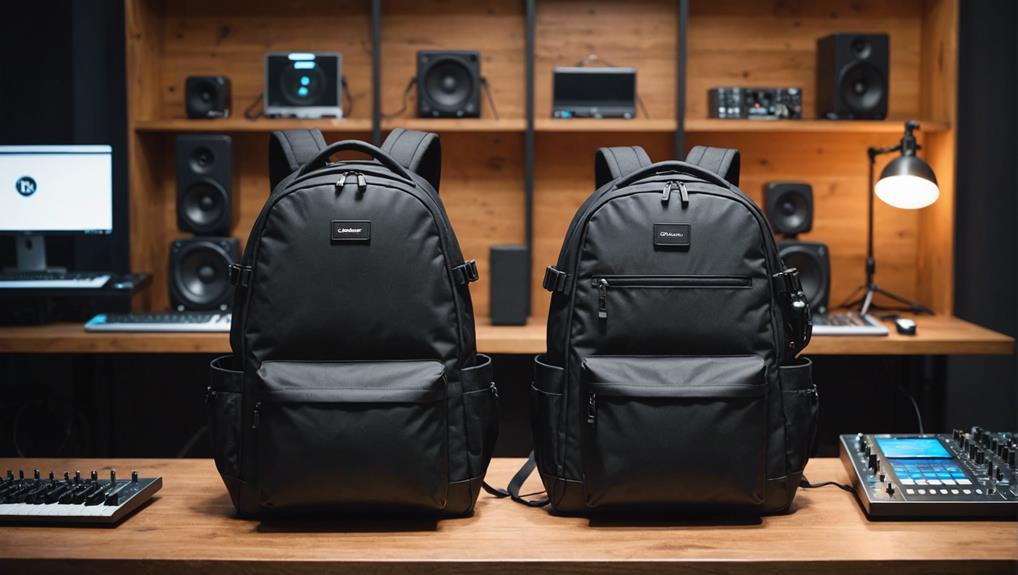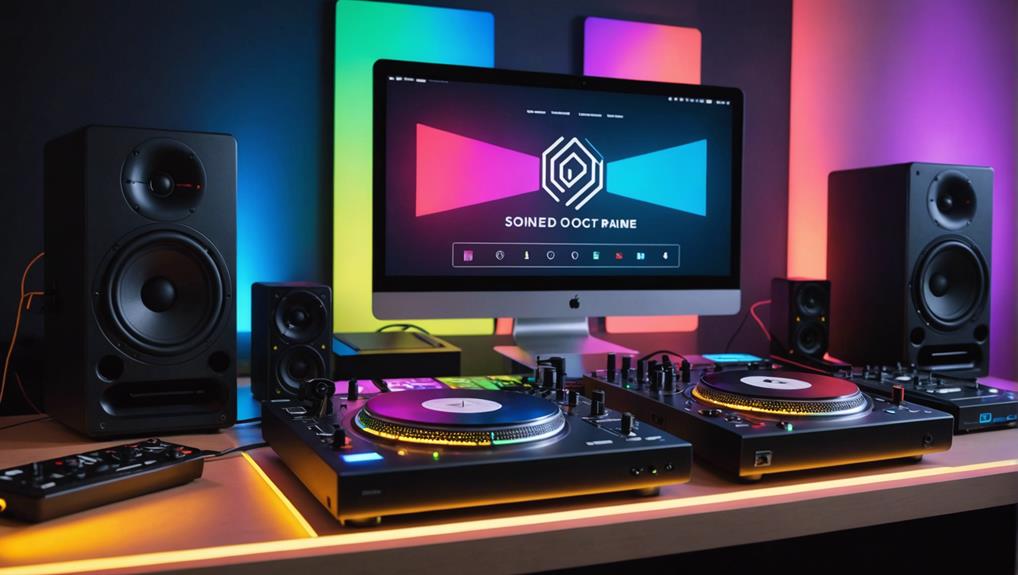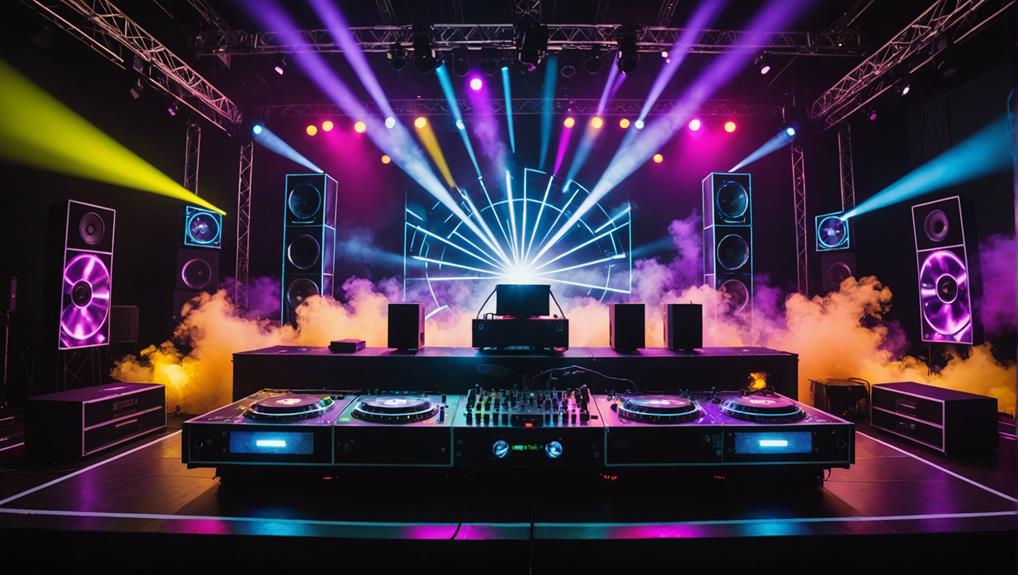No products in the cart.
First, familiarize yourself with your DJ controller’s layout, paying close attention to essential controls like jog wheels, faders, and knobs. You’ll need to efficiently navigate your DJ software, mastering playback controls and customizing the interface to fit your workflow. Sharpen your beatmatching skills by practicing tempo adjustments and using jog wheels for fine-tuning. Experiment with blending techniques, ensuring smooth sync between tracks. Utilize built-in effects like filters and reverb to enhance your sound, and don’t overlook the importance of mastering EQ adjustments for seamless mixes. Record and analyze your mixes to track progress and fine-tune your technique. Regularly update your controller and explore new features to stay ahead. With each step, you’ll discover more about maximizing your controller’s full potential.
Contents
hide
Key Takeaways
- Familiarize yourself with the DJ controller’s layout, including jog wheels, faders, and knobs for efficient use.
- Practice beatmatching by adjusting tempos and using jog wheels to align tracks.
- Utilize built-in effects like filters, delay, and reverb to enhance and diversify your mixes.
- Record and analyze your mixes to identify areas for improvement and track your development over time.
- Stay updated with new features and firmware updates to maximize your controller’s capabilities and maintain performance.
Understand Your Controller Layout
To master your performances, it’s important you first familiarize yourself with your DJ controller’s layout, pinpointing essential controls like jog wheels, faders, and knobs. The controller design isn’t just about aesthetics; it involves ergonomic positioning that enhances your mixing efficiency. Make sure you’re comfortable with the placement of these elements. The jog wheels, for instance, should be easily reachable, allowing for smooth operation during intense mixing sessions.
Understanding each control’s purpose is essential. Faders manage volume levels, while knobs might adjust effects parameters or equalization settings. This knowledge allows for intuitive use during live performances, helping you react swiftly to the dynamic club environment.
Moreover, explore custom mapping to tailor your controller to fit your unique style, enhancing your performance customization. This process involves reassigning standard control functions to actions that suit your workflow better, ensuring that every move you make is deliberate and impactful.
Lastly, don’t overlook the importance of practice. Regularly familiarizing yourself with your controller’s layout not only builds muscle memory but also boosts your confidence, ensuring you’re always ready to deliver a stellar performance.
Learn Basic DJ Software Functions
To master your DJ software, you’ll first need to navigate its interface efficiently. Understand how to use the playback controls like play, cue, sync, and pitch to manipulate tracks seamlessly.
This foundational knowledge is essential for setting up your mixes and enhancing your performance skills.
Explore Interface Layout
Understanding the interface layout of your DJ software is essential for efficiently managing your tracks and mastering various mixing techniques. By familiarizing yourself with sections like decks, mixers, effects, and libraries, you’ll navigate through your DJ software with ease. This knowledge not only enhances your performance but also empowers you with skills necessary for advanced mixing techniques and interface customization.
- Interface Customization: Tailor the software layout to fit your unique workflow, enhancing your mixing efficiency.
- Advanced Mixing Techniques: Utilize the layout to apply effects and smoothly switch between tracks.
- Library Organization: Efficiently sort and access your music, easing track selection during live sets.
- Track Selection Strategies: Quickly find and load tracks, keeping the energy high and your audience engaged.
Utilize Playback Controls
Get familiar with the essential playback controls such as play, pause, cue, and sync on your DJ controller to streamline your mixing process. Mastering these basics is important for executing advanced mixing techniques.
Explore track selection strategies by efficiently using the jog wheels or navigation buttons. This helps you smoothly move through your playlist without disrupting the flow.
You’ll also want to harness the power of cue point applications, positioning them strategically for quick access during performances. Additionally, utilize the pitch fader for tempo adjustment tricks, ensuring your tracks blend well in real-time.
Perfecting these elements not only enhances your skill set but also enhances your live DJ sets, keeping your audience engaged.
Practice Beatmatching Skills
Start mastering beatmatching by adjusting the pitch fader to align the tempos of two tracks seamlessly. As you explore the art of DJing, perfecting your beatmatching skills is vital. This technique guarantees that your music flows without interruption, maintaining the energy on the dance floor. Here are key points to focus on:
- Tempo adjustment techniques: Learn to manipulate the pitch fader with precision. A slight adjustment can make a significant difference.
- Beatmatching troubleshooting: If the beats drift apart, use the jog wheels to nudge the tracks back into alignment. Listen closely for any discrepancies in the beat.
- Beatmatching practice routines: Set aside regular practice sessions solely for beatmatching. Start with simpler tracks that have clear, steady beats before moving on to more complex rhythms.
- Beatmatching track selection: Choose tracks with similar BPMs to practice. This simplifies the learning process and helps you focus on the nuances of timing and ear training.
Explore Transition Techniques
As you progress in mastering blending techniques on your DJ controller, prioritize seamless beat matching. This skill guarantees that tracks flow into each other without noticeable disruption, sustaining the dance floor’s energy.
Then, explore creative crossfader usage to introduce unique effects and textures, elevating your sets beyond the basics.
Seamless Beat Matching
To master seamless beat matching, you’ll need to synchronize tracks meticulously to avoid tempo clashes. Utilizing tempo synchronization techniques and waveform analysis, you can precisely align tracks. This method not only enhances your mix’s flow but also enhances your performance’s professionalism.
Here’s how you can boost your beat matching skills:
- Practice manual beatmatching to fine-tune your ear and adapt quickly during live sets.
- Use waveforms for visual guidance on beat alignment, ensuring flawless shifts.
- Adjust tempo sliders carefully to match the beats per minute (BPM) of the tracks.
- Set and utilize cue points to mark critical beats, simplifying real-time adjustments.
Creative Crossfader Usage
Building on your beat matching skills, mastering the crossfader is key to enhancing the dynamics of your DJ sets. Immerse yourself in creative scratching techniques to inject a personal touch and dynamic shifts into your mixes. Experiment with quick, sharp movements or smooth, gradual fades depending on the mood you’re aiming for.
Here’s a breakdown of techniques to enrich your performance:
| Technique | Effect on Track | Use Case |
|---|---|---|
| Quick Cut | Sharp, precise entry | High-energy moments |
| Long Fade | Smooth blending | Seamless shifts |
| EQ + Fader Combo | Unique sound texture | Creative expression |
Focus on advanced crossfader techniques to add performance flair. Remember, every movement of the fader can transform the energy and flow of your set.
Utilize Built-In Effects
Mastering the built-in effects on your DJ controller, such as filters, delay, and reverb, can enhance your mixes by adding depth and excitement. By understanding the nuances of each effect—knowing when to dial up the reverb for a larger-than-life sound or tighten up with a quick filter sweep—you’re not just playing tracks, you’re crafting a sonic journey.
Here’s how you can leverage these tools to improve your DJ performances:
- Explore Filters: Use high-pass and low-pass filters to create smooth shifts or to highlight specific elements in a track.
- Delve into Delay: Sync delay times with your track’s BPM for rhythmic enhancements that keep the crowd engaged.
- Refine with Reverb: Add reverb to introduce a sense of space, making your mix sound bigger and more immersive.
- Customize Your Effects: Don’t rely solely on presets. Tweak parameters to match the energy and mood of your performance.
Incorporating these strategies not only demonstrates your advanced effects manipulation and sound manipulation mastery but also enhances your creative mixing techniques. This commitment to performance improvement strategies ensures your sets resonate deeply with your audience, making each performance memorable.
Experiment With Looping
Explore looping to effortlessly repeat sections of a track, enhancing your mix’s dynamism and maintaining audience interest. As you investigate your DJ controller’s looping features, you’ll find that looping creativity isn’t just about filling space—it’s a strategic tool to amplify performance energy and keep your crowd hooked.
Start by experimenting with different loop lengths. Short loops can create a hypnotic effect, whereas longer loops allow for more elaborate blends and connections. This technique not only builds tension but also gives you the freedom to prepare your next track seamlessly. Use the loop function to accentuate beats or extend a break, ensuring the dance floor stays lively.
Additionally, practice adjusting loop points in real-time. This skill is essential for ensuring your loops are tight and your beats are perfectly aligned, which is vital for smooth connections. Remember, the goal is to make these adjustments without disrupting the flow of your set.
Looping isn’t just a technical skill but an expression of your artistic flair. Engage with it to explore new dimensions in your performances, keeping your sets fresh and your crowd engaged. By mastering looping techniques, you’ll enhance both your mixes and your confidence behind the decks.
Master EQ Adjustments
Adjusting the EQ on your DJ controller allows you to finely balance the frequencies, ensuring smooth switches between tracks. Mastering EQ adjustments is essential for not only maintaining the integrity of each track but also for enhancing the entire set’s audio dynamics. As you blend tracks, focus on EQ precision to create a seamless mix.
Here’s how you can harness the power of EQ adjustments:
- Experiment with cutting and boosting: Cut the bass to avoid muddiness or boost the treble for clarity during crowded parts of your set.
- Maintain track integrity: Avoid over-adjusting, which can lead to a loss of the track’s original character.
- Use EQ for transformations: Smoothly transform between tracks by adjusting EQs to complement each other, enhancing the flow of your set.
- Develop your signature sound: Use EQ adjustments to put your unique stamp on your mixes, potentially redefining tracks in innovative ways.
Record and Analyze Your Mixes
Recording your mixes with software like Serato DJ provides an essential playback resource for analyzing and refining your DJ skills. By capturing your live sessions directly from your controller, you’re equipped with a powerful tool for detailed mix analysis. This process allows you to pinpoint areas in your blending, track selection, and EQ mixing that may need improvement. Listening back to your mixes can reveal subtle issues that aren’t always apparent in the heat of a live performance.
As you review your recorded sessions, track your progress and development. Comparing various recordings over time illuminates your growth, helping you understand how your skills have evolved. This performance tracking is vital for consistent skill development in the competitive world of DJing.
Moreover, focus on identifying patterns within your mixes. Recognizing recurring mistakes or successful techniques will guide your practice sessions, making them much more targeted and efficient. This strategic approach ensures that every practice session directly contributes to your improvement, fine-tuning your mastery of the DJ controller and boosting the overall quality of your performances.
Perform Live Practice Sets
After perfecting your skills through recorded session reviews, you should now regularly perform live practice sets to further enhance your mastery of the DJ controller. Diving into live settings sharpens your ability to handle real-time scenarios, where quick thinking and adaptability are key. It’s not just about playing music; it’s about creating a vibe and connecting with your audience, even if it’s just friends or an online stream.
Incorporate these steps into your practice routine to enhance your performance:
- Experiment with Changes: Try out various mixing techniques to find what works best for different music styles. This hones your technical skills and prepares you for any set.
- Focus on Genre-Specific Sets: Tailoring your sessions to specific genres enhances your versatility and understanding of what gets a particular crowd going.
- Engage with Your Imaginary Audience: Practice crowd interaction and energy management to build your confidence and ability to engage with real audiences.
- Record and Reflect: Always record your sets to review later. This reflection helps you notice subtle cues and areas for improvement.
These practice sessions are important in developing not just your technical skills but also your performance flair and stage presence.
Stay Updated With New Features
To stay at the forefront of your DJing game, it’s important to regularly update your DJ controller with the latest firmware and features. Firmware updates can greatly enhance your controller’s performance and introduce new functionalities that keep your sets fresh and engaging.
Joining online communities and forums dedicated to your DJ controller brand is essential. Here, you’ll get firsthand tips and can engage in discussions that highlight new updates and creative usage techniques. Community engagement helps you leverage collective knowledge and experiences, improving your skills and keeping you at the cutting edge.
Make sure you’re following the manufacturer on social media. This is a quick way to receive real-time announcements about software upgrades and feature enhancements. Social media platforms often provide immediate access to updates and community feedback.
Attending workshops and webinars is another effective way to stay informed. These sessions often cover advanced functionalities and best practices that can bring your DJing to a professional level.
Experiment with new features as you learn about them. Testing out different settings and features not only builds your expertise but also enhances your performances and mix innovations.
Quick Reference Guide: Staying Updated
| Source | Benefit |
|---|---|
| Firmware Updates | Access new features and enhanced stability |
| Online Communities | Tips and peer support |
| Social Media | Immediate updates and news |
| Workshops | Advanced functionalities and best practices |
| Experimentation | Hands-on learning and creativity enhancement |
Frequently Asked Questions
How to Master a DJ Set Recording?
To master a DJ set recording, choose a quiet recording environment and select the right software. Record with headroom, then edit for consistent volume levels, and use mastering techniques to enhance sound quality.
How to Learn DJ Step by Step?
To learn DJing step by step, start with your equipment setup. Master loading tracks and adjusting settings. Then, practice beat matching to guarantee smooth shifts. Gradually, explore more complex mixing techniques.
What Is the Most Important Skill for a Dj?
The most important skill for a DJ is beatmatching, ensuring smooth track changes. Mastering it, alongside crowd reading and genre blending, enhances your performances, keeping the dancefloor energetic and engaged.
How to Improve Your DJ Skills?
To improve your DJ skills, practice beat matching to guarantee smooth switches. Additionally, hone your crowd reading abilities to adapt your set dynamically, keeping the energy high and the audience engaged.




